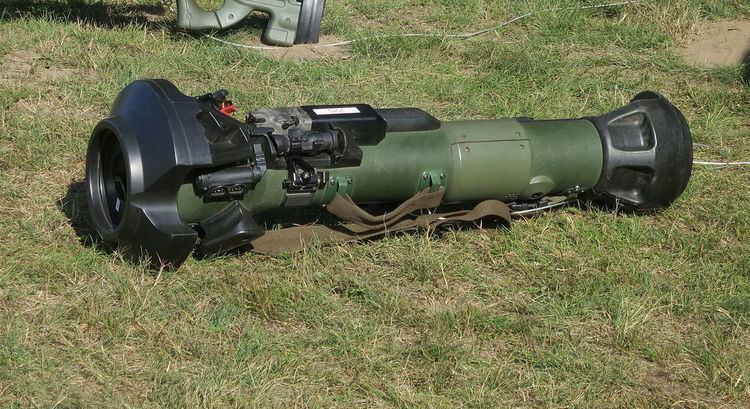Place of origin Sweden
United Kingdom Designed May 2002 | Designer Saab Bofors Dynamics Manufacturer Thales Air Defence | |
 | ||
Type Anti-tank missile launcher Used by Sweden
United Kingdom
Luxembourg
Finland | ||
The Main Battle Tank and Light Anti-tank Weapon (MBT LAW), also known as the NLAW, is a joint British and Swedish short-range fire-and-forget anti-tank missile system. Designed for use by infantry, the MBT LAW is shoulder fired and disposable, firing once before being disposed of. It is currently in use with the military forces of the United Kingdom, Finland, Luxembourg, and Sweden.
Contents
Overview
The MBT LAW was developed by Saab Bofors Dynamics and Thales Air Defence in consolidation with the Ministry of Defence (United Kingdom) in 2002. The development is a joint venture between the UK and Sweden using technology derived from the BILL 2 (warhead and guidance), and AT4 CS (confined space capability) systems. The UK MoD Defence Procurement Agency will procure the systems for both the UK and Sweden, with Sweden signing a contract for the weapon in December 2005 where it will be designated the "RB (Robot) 57". It has been estimated that the UK requirement may be for up to 20,000 systems for the British Armed Forces and each system has a shelf life of around 20 years. In December 2007, Finland placed an order for an undisclosed number of NLAW systems. An additional (undisclosed) number was ordered in December 2008. It is a soft-launch system, allowing it to be used by infantry from within an enclosed space. In this system, the missile is first launched out of the launcher using a low powered ignition. After the missile travels several meters into flight, its main rocket ignition occurs, which propels the missile from there on, to the target. Guidance is obtained using predicted line of sight (PLOS); for a moving target, the gunner maintains tracking for three seconds, training the missile's guidance electronics to compute the target's angular speed. After launch the missile flies autonomously to the target adjusting the necessary corrections according to the data acquired by the tracking. It is unnecessary for the gunner to consider the range to the target. After launch the missile's position in its trajectory always coincides with the target irrespective of range.
The portable, short range, fire-and-forget system entered service in 2009 as the NLAW (Next Generation Light Anti-tank Weapon), to replace the British Army's existing LAW 80 system that had reached its obsolescence, as well as the ILAW (AT4 CS) (Interim Lightweight Anti-tank Weapon), which was in deployment as a substitute for the period in which the MBT-LAW had yet to be deployed. Deliveries began in December 2009.
Development
Both launcher and missile development are carried out at Saab Bofors Dynamics facilities at Eskilstuna and Karlskoga in Sweden using the expertise gained on anti-armour systems such as the Carl Gustav recoilless rifle, the AT4 CS confined spaces weapon and the Bill anti-tank missile. Thales Air Defence is the major UK partner and contributor to the program, leading Team MBT LAW which includes 14 UK subcontractors for the manufacture of the weapon system and its components. Final assembly and testing is carried out at the Thales Air Defence facilities in Belfast. The missile's inertial measurement unit (IMU) is manufactured by BAE Systems at its semiconductor facilities in Plymouth, where the silicon rate sensors in the IMU are manufactured. FR-HiTEMP, based in Titchfield, is responsible for the manufacture of the control fins and actuators. Raytheon Systems Limited based in Glenrothes, and Thales Missile Electronics based in Basingstoke, manufacture electronics assemblies and the systems proximity fuse. National Plastics Aerospace based in Coventry, is responsible for the plastic and composite mouldings. Skeldings, based in Smethwick, manufacture the system's special purpose springs. Express Engineering of Gateshead, Portsmouth Aviation, EPS Logistics Technology, Leafield Engineering of Bristol and Metalweb in Birmingham are also major partners in the MBT LAW consortium.
